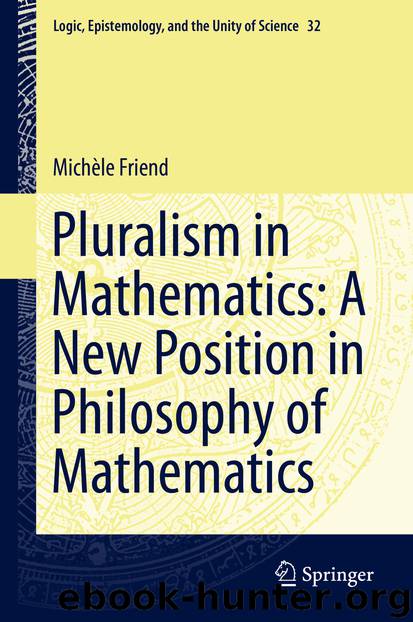Pluralism in Mathematics: A New Position in Philosophy of Mathematics by Michèle Friend

Author:Michèle Friend
Language: eng
Format: epub
Publisher: Springer Netherlands, Dordrecht
(c)There is the invitation to explore the limitations of the results: the limitations of the theorem and the justifications for the theorem.
Working backwards: exploring the limitations (c) is done by looking to the class of meta-theories. If we know something of the class of meta-theories within which the proof is acceptable, we know a lot about the scope of the proved theorem. Of course, the relation is not tight or complete in practice, since we might not know what the maximal meta-theory is, so what the maximal scope of the theorem is. Also, we might not know what the minimal meta-theory is, so the minimum needed to justify a theorem. Reverse mathematics only goes some way to helping us to be precise.9 Worse still, we might not have a particular meta-theory in mind at all, and might just help ourselves to ‘whatever it takes’ or ‘whatever seems appropriate’ to verify a proof, and defer learning about some relevant meta-theories. We saw an example of this in Chap. 5, when we discussed the classification of finite simple groups. So the ‘theory’ in ‘meta-theory’ might not be an explicit theory at all, but more the background knowledge, and general context, which we assume can be made more explicit if necessary.
What we do know is that if the proof of a theorem is acceptable in a meta-theory (or a class of meta-theories), then we know it will be true along with every theorem of theories verifiable by that meta-theory or that class of meta-theories. The exploration of the limitations, constraints of a theorem or idea is where a lot of the interesting work is done in mathematics. Referring to (b), what is nice about giving a very transparent and meticulous proof is that the justification is exposed. It can then be scrutinised, questioned, corrected, developed etcetera. Sometimes we confirm, and sometimes we innovate, as a result of scrutinising our justification. In this sense, scrutiny is a means of understanding or making links between mathematical theories. The scrutiny exposes (a) the conjectural aspect of the idea, or theorem. We shall not say more about this here. Discussion is deferred to Chap. 12.
Before moving to the next section, it might be worth distinguishing justification from explicitness. ‘Justification’, as it is used here, is a term we take from the constructivists, such as Martin-Löf and Sundholm (Sundholm 2000, 6–7). They believe that judgments are made of theorems known. For a constructivist, knowledge does not come in degrees. Justification is a wholly epistemic notion; and while a particular justification, (or set of justifications) could be in error, if we are assured that no error has been made, then we have certain knowledge.
The notion of ‘explicitness’ is looser. The pluralist ‘rigour as explicitness’ view is not just comprised of the twins: justification and error in proof. For, the justification can itself be questioned and scrutinised. For the pluralist, knowledge rests on justification, and justification is not absolute. While justification and knowledge are mirrors of each other, they both vary together.
Download
This site does not store any files on its server. We only index and link to content provided by other sites. Please contact the content providers to delete copyright contents if any and email us, we'll remove relevant links or contents immediately.
| Algebra | Calculus |
| Combinatorics | Discrete Mathematics |
| Finite Mathematics | Fractals |
| Functional Analysis | Group Theory |
| Logic | Number Theory |
| Set Theory |
Modelling of Convective Heat and Mass Transfer in Rotating Flows by Igor V. Shevchuk(6393)
Weapons of Math Destruction by Cathy O'Neil(6156)
Factfulness: Ten Reasons We're Wrong About the World – and Why Things Are Better Than You Think by Hans Rosling(4696)
Descartes' Error by Antonio Damasio(3233)
A Mind For Numbers: How to Excel at Math and Science (Even If You Flunked Algebra) by Barbara Oakley(3226)
Factfulness_Ten Reasons We're Wrong About the World_and Why Things Are Better Than You Think by Hans Rosling(3202)
TCP IP by Todd Lammle(3138)
Fooled by Randomness: The Hidden Role of Chance in Life and in the Markets by Nassim Nicholas Taleb(3051)
Applied Predictive Modeling by Max Kuhn & Kjell Johnson(3021)
The Tyranny of Metrics by Jerry Z. Muller(3009)
The Book of Numbers by Peter Bentley(2914)
The Great Unknown by Marcus du Sautoy(2651)
Once Upon an Algorithm by Martin Erwig(2603)
Easy Algebra Step-by-Step by Sandra Luna McCune(2588)
Lady Luck by Kristen Ashley(2537)
Practical Guide To Principal Component Methods in R (Multivariate Analysis Book 2) by Alboukadel Kassambara(2498)
Police Exams Prep 2018-2019 by Kaplan Test Prep(2490)
All Things Reconsidered by Bill Thompson III(2359)
Linear Time-Invariant Systems, Behaviors and Modules by Ulrich Oberst & Martin Scheicher & Ingrid Scheicher(2335)
